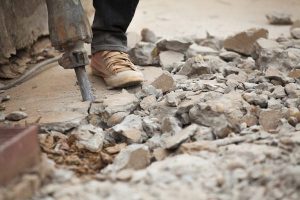Concrete scanning is an essential part of any construction project. Without it, you can’t be sure that the concrete around the construction site is safe – concrete scanning allows you to determine where any underground lines or structural components are. Running into these things in the concrete accidentally when you cut or drill can have huge repercussions for the safety of your site and crew and to the people around the area.
Concrete Scanning Involves Surveying the Land
Completing a land survey is often going to be the first step in concrete scanning. Surveying is often associated with determining legal boundaries, such as property lines, but it is also part of concrete scanning. A good survey will set the stage for efficient use of ground-penetrating radar, including locating areas for the radar technician to focus on based on where utilities are supposed to be based on maps. Surveying also may include clearing the area, so the ground-penetrating radar has space to work freely.
Ground Penetrating Radar
Ground Penetrating Radar is a form of non-invasive imaging, meaning that it doesn’t destroy or even endanger the concrete or anything inside it. This amazing tool uses radio waves or pulses which move out from the equipment, through the ground and then bounce back when they hit obstructions, such as utilities, tension wires, rebar, and other things. Based on how far the pulses go before bouncing back, this tool can be used to determine where in the ground, these things are and to plan how to drill or cut without hitting them. The actual scanning doesn’t take a super long time, though doing a huge area will obviously take longer than doing a small area.
Reading Results After Concrete Scanning
It is important to remember that the ground-penetrating radar tool gives back information, not a ready-made picture – this is why it is important to work with a professional who can read the results. Unless you are a concrete scanning professional, simply having or renting the tool is not going to be enough. The technician will use the data obtained through the ground penetrating radar to determine where potential hazards are and mark them, so your crew doesn’t cause damage or injure themselves. Having this information can also keep your job on track financially and on schedule because you won’t be slowed down by unexpected obstacles in the concrete (or have to make repairs to utilities).
Concrete Visions Will Get The Job Done Right
Concrete Visions has been working with clients for over 25 years. Our G&M Services installers are certified with the industry’s major firestop product manufacturers. As part of our firestop service, we can assess abnormal field conditions and, with the manufacturer’s technical support assistance, provide engineering judgments in a timely fashion to comply with contract specifications. Our Field Mechanics undergo ongoing training, including mandatory monthly safety meetings, weekly Toolbox Talks where safety and equipment information is shred, and trainings on safe work standards and safety best practices.

